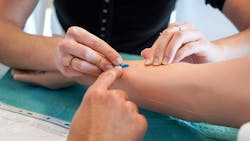Catheters and Infusion Pumps: Trends, Advancements, and Education
Writing about catheters and infusion pumps is not new for Healthcare Purchasing News. In December of 2022, we covered catheters in our print magazine, we wrote, “As a device that enters the body, a catheter has the potential to cause infection, while some designs and purposes present greater risk than others.”
A blog post from Infectious Diseases Society of America, stated, “In a recent article in Clinical Microbiology and Infection, Buetti et al. evaluated the infection risk from different types of intravenous catheters in place for more than 10 days and the risk factors associated with infection.
“The investigators analyzed data from four randomized controlled trials that had been conducted to assess interventions for preventing catheter infections. They evaluated 15,036 intravascular catheters from 24 intensive care units in France.
“Infections occurred in 46 (0.7%) of 6,298 arterial catheters, 62 (1.0%) of 6,036 central venous catheters and 47 (1.7%) of 2,702 short-term dialysis catheters. By using a Cox model, the investigators found that interaction between dwell time beyond 10 days and catheter type was significant for CVCs (P = .008) and DCs (P < .001), thus indicating an increased risk of infection after 10 days. The interaction was not significant for ACs (P = .98).”
Now, as we enter 2024, HPN spoke with two educational experts on catheters and infusion pumps to get the scoop on the latest as it pertains to current trends and educating staff on this important, and sometimes overlooked, topic.
Past and current trends
Diane K. Newman, DNP, CRNP, FAAN, BCB-PMD gave HPN a brief overview on past and current trends for urinary catheters. She said, “Since the beginning of time, people develop problems where they cannot urinate, so they can't empty their bladder. In the past, people would use steel rods, weeds, and all different things to put into the bladder, so that if there was something obstructing the area to drain urine out. This was only actually in the beginning. During WWI the balloon retention catheter was invented by Frederick Foley, who was a urologist, and basically that allowed individuals who could not urinate from a war injury to have a device in place that could drain the urine out and it had a balloon so that it stayed in the bladder. And that was actually called, and what we call a Foley catheter.”
She added, “In that area, there haven’t been a lot of changes since. Yet, if it stays in more than a month, it can cause problems, especially infections, and that's become a really driving issue with government agencies, especially Medicare, because the cost of what we call a catheter associated earning your track infection or just significant and it also increases mortality and individuals. So, the goal has been to not use these types of catheters long term.”
Nancy Moureau, RN, PhD, CRNI, CPUI, VA-BC is CEO of PICC Excellence Inc., said, “We definitely saw a change in the way we were having to monitor patients during COVID because of the need to have full protection and limitation on those supplies over time. Infusion pumps were brought outside the room so they could be managed and programmed so that medications could be changed, longer tubing was attached—there were many of work arounds established that weren't all necessarily good and that has all gone away now since the epidemic has passed.”
“I hope that we've learned a number of things through that process and how well infusion pumps work is as important of an aspect as well as the alarms that are associated with pumps. But we also have to recognize the impact that a catheter has on the function of the infusion pump. If it's a peripheral catheter that becomes obstructed, then the pump is going to alarm. Why is it alarming? Then you have to figure that out and back it up to the catheter. Even the different devices used on the catheters will impact the function of the pump, such as the needleless connectors.
“Based on the research that I've done, installing antireflux needleless connectors are key to reducing the level of occlusion and increasing function of all types of catheters, peripheral and central. So just little changes, little improvements like making sure that you are using antireflux connectors instead of the positive pressure, negative pressure and so called neutral which there truly are no neutral needleless connectors.”
Moureau added, “There have been some significant improvements over the last few years with some materials that have been released that seem to be performing at a higher level than other types of catheters. Over the last 30 years or so we've had antimicrobial catheters, we've had multiple catheters that came out that supposedly had antithrombotic characteristics with research showing differing levels of effectiveness of the antithrombotic components. Now we have a catheter material that is considered hydrophilic and hydrogel, which the hydrophilic or water loving quality of this catheter reduces the adherence of cells. And so, by nature of that hydrated surface, you're going to have an antithrombotic and potentially an antimicrobial catheter that reduces biofilm formation.”
Education is key
Newman commented, “I teach at the School of Nursing at the University of Pennsylvania, which is one of the top nursing schools in the country. I do what we call the GU urinary or bowel and bladder lectures at the undergraduate and graduate level and I don't I get an hour or two hours. I can't even get into catheters because of all the other topics.
“I always ask the students how many of you have put a catheter in a patient in their training and maybe one or two hands go up and they and other people say they practice on models, or they use simulation stuff so there isn't a lot of education.”
She added, “The thing is, there is a lack of education and there’s no question. You have very novice registered nurses coming out of hospitals. And I have to tell you, they're using [catheters] inappropriately. There's a lot of information on this as far as recommendations, for example the CDC has recommendations on when it's appropriate or not appropriate to use a catheter. They are put in sometimes at the nurses’ convenience—for example say someone who was incontinence and they leak all the time, as opposed to changing their pads, it is just easier to leave a catheter in. Sometimes nurses do it to decrease nursing burden, as it is a nightmare right now in hospitals and healthcare as far as nursing burnout. So, it's a real issue and it's easy to manage a patient if you have a catheter in, even though we all know it's more harmful to the patient.”
When asked about her organization, Moureau said, “PICC Excellence was formed in 1994 as an education service provider and a resource for clinicians who wanted to learn more about peripherally inserted central catheters. And later we expanded into midlines and all different types of intravenous devices.”
“We felt like in the beginning there just wasn’t enough information and resources available,” she added. “We simply wanted to be a source of information. We focus on evidence-based practice and very practical education and training. PICC Excellence not only has online educational courses and pathways that are specific to different devices and care and maintenance and foundations and vascular access, essentials of infection prevention and various age groups of adult, pediatric and neonatal, but we also have workshops where we provide simulation, training and opportunities for precepted insertions in various locations across the United States.”
Moureau continued, “We also spread information and education and training, and not only in the United States, but in various parts of the world with different organizations. I am a speaker, especially in relation to the research that I performed and many of the courses that I've developed. I've worked closely with the World Congress of Vascular access as a committee chair and consensus leader for minimum training requirements for central venous catheters and a new project where I'm a committee member updating that information. And so PICC excellence is just involved in a variety of ways to spread knowledge, to provide a good quality education.”
Additionally, she added that PICC Excellence also has certification programs because Moureau personally felt it was necessary for clinicians to prove that they had completed the qualification process. The certifications she said are certified PICC, ultrasound inserted (which is primarily for adult and pediatric clinicians) CPUI, and a certified neonatal PICC inserter certification for PICC lines, CNPI, that were released a year ago, along with two new IV Therapy and Ultrasound Mastery Learning Certificate programs.
Moureau also said, “We've also recognized some issues with variation and fragmentation with ultrasound guided peripheral catheter insertion training. We have done research on that to validate and then have worked closely with a number of groups in Washington state, as well as Chicago to create an ultrasound guided peripheral catheter mastery learning certificate process. We've also created another one for IV therapy that meets state requirements for licensed, practical and licensed vocational nurses and a graduate nurses and others who want to learn just general IV therapy.”
PICC Excellence also offers custom on-site training where hospitals contract with the organization to provide specific types of education that meet their goals and needs. In conclusion, the aim of PICC Excellence is to promote the application of best practices for all types of vascular access and infusion therapy to benefit patients with the best outcomes for their treatment process. We know, according to research, that education of clinicians results in improved outcomes for patients.


